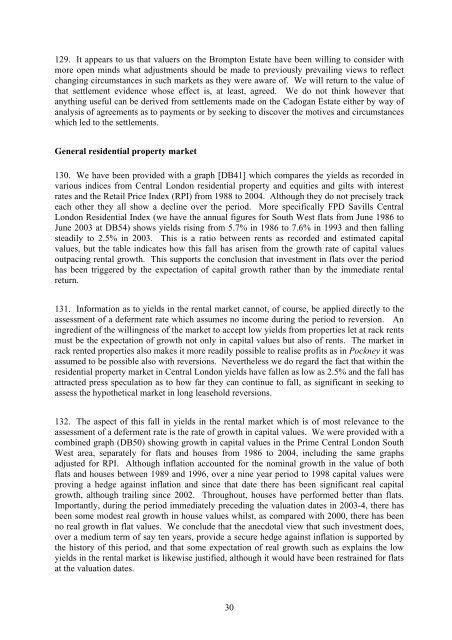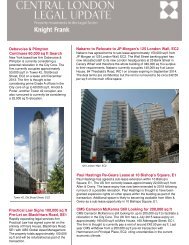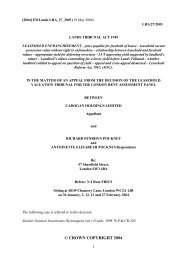40 Chelsea Square - Knight Frank
40 Chelsea Square - Knight Frank
40 Chelsea Square - Knight Frank
You also want an ePaper? Increase the reach of your titles
YUMPU automatically turns print PDFs into web optimized ePapers that Google loves.
129. It appears to us that valuers on the Brompton Estate have been willing to consider with<br />
more open minds what adjustments should be made to previously prevailing views to reflect<br />
changing circumstances in such markets as they were aware of. We will return to the value of<br />
that settlement evidence whose effect is, at least, agreed. We do not think however that<br />
anything useful can be derived from settlements made on the Cadogan Estate either by way of<br />
analysis of agreements as to payments or by seeking to discover the motives and circumstances<br />
which led to the settlements.<br />
General residential property market<br />
130. We have been provided with a graph [DB41] which compares the yields as recorded in<br />
various indices from Central London residential property and equities and gilts with interest<br />
rates and the Retail Price Index (RPI) from 1988 to 2004. Although they do not precisely track<br />
each other they all show a decline over the period. More specifically FPD Savills Central<br />
London Residential Index (we have the annual figures for South West flats from June 1986 to<br />
June 2003 at DB54) shows yields rising from 5.7% in 1986 to 7.6% in 1993 and then falling<br />
steadily to 2.5% in 2003. This is a ratio between rents as recorded and estimated capital<br />
values, but the table indicates how this fall has arisen from the growth rate of capital values<br />
outpacing rental growth. This supports the conclusion that investment in flats over the period<br />
has been triggered by the expectation of capital growth rather than by the immediate rental<br />
return.<br />
131. Information as to yields in the rental market cannot, of course, be applied directly to the<br />
assessment of a deferment rate which assumes no income during the period to reversion. An<br />
ingredient of the willingness of the market to accept low yields from properties let at rack rents<br />
must be the expectation of growth not only in capital values but also of rents. The market in<br />
rack rented properties also makes it more readily possible to realise profits as in Pockney it was<br />
assumed to be possible also with reversions. Nevertheless we do regard the fact that within the<br />
residential property market in Central London yields have fallen as low as 2.5% and the fall has<br />
attracted press speculation as to how far they can continue to fall, as significant in seeking to<br />
assess the hypothetical market in long leasehold reversions.<br />
132. The aspect of this fall in yields in the rental market which is of most relevance to the<br />
assessment of a deferment rate is the rate of growth in capital values. We were provided with a<br />
combined graph (DB50) showing growth in capital values in the Prime Central London South<br />
West area, separately for flats and houses from 1986 to 2004, including the same graphs<br />
adjusted for RPI. Although inflation accounted for the nominal growth in the value of both<br />
flats and houses between 1989 and 1996, over a nine year period to 1998 capital values were<br />
proving a hedge against inflation and since that date there has been significant real capital<br />
growth, although trailing since 2002. Throughout, houses have performed better than flats.<br />
Importantly, during the period immediately preceding the valuation dates in 2003-4, there has<br />
been some modest real growth in house values whilst, as compared with 2000, there has been<br />
no real growth in flat values. We conclude that the anecdotal view that such investment does,<br />
over a medium term of say ten years, provide a secure hedge against inflation is supported by<br />
the history of this period, and that some expectation of real growth such as explains the low<br />
yields in the rental market is likewise justified, although it would have been restrained for flats<br />
at the valuation dates.<br />
30









